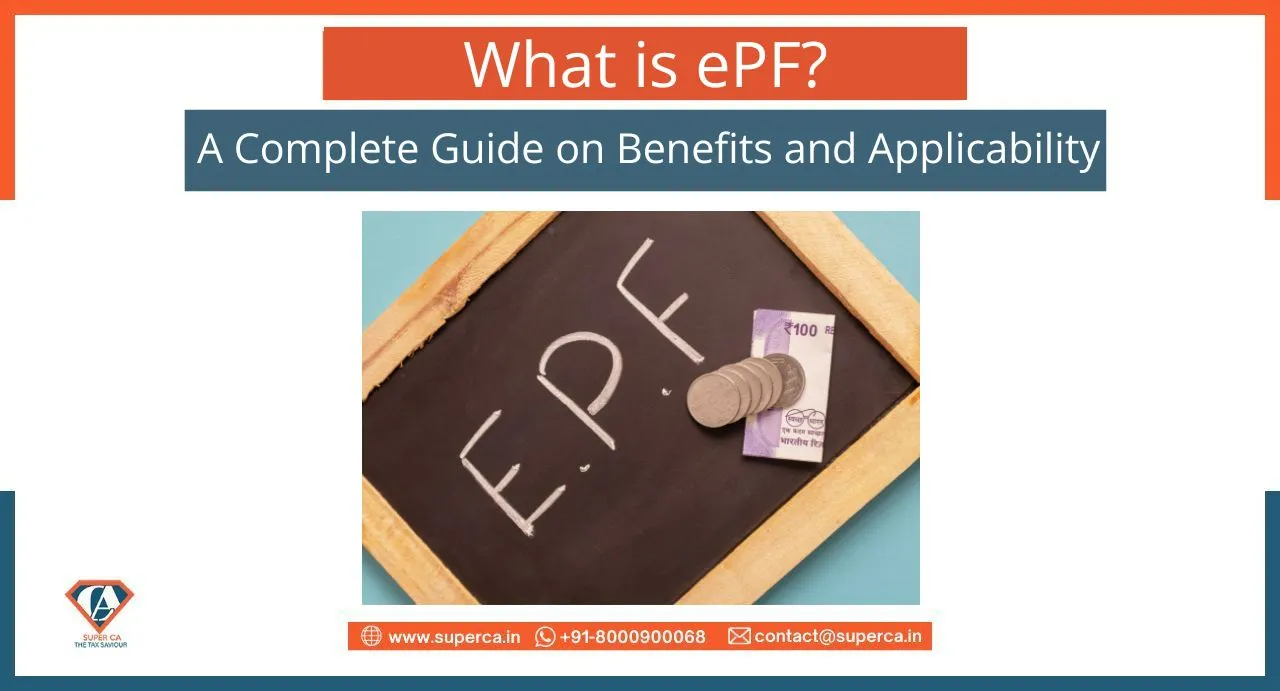What is ePF? A Complete Guide on Benefits and Applicability
- Posted By SuperCA
- On 29 July

EPF (Employees’ Provident Fund) is a retirement benefits scheme maintained by the Employees’ Provident Fund Organization (EPFO) and regulated under the Employees' Provident Funds and Miscellaneous Provisions Act, 1952. Under the EPF scheme, an employee has to pay a certain contribution towards the scheme, and an equal contribution is paid by the employer on a monthly basis. The employee gets a lump sum amount including self and employer's contribution with interest on both, on his/her retirement.
Payment Procedure
Employee’s contribution
The employer deducts 12% of the employee’s salary (basic + dearness allowance) directly every month for a contribution towards EPF. This contribution entirely goes to the EPF account of the employee.
Employer’s contribution
Similarly, the employer also contributes 12% of the employee’s salary towards EPF. Out of this contribution, 8.33% is directed towards the Employee Pension Scheme and the remaining 3.67% goes to the EPF account of the employee.
Applicability
The eligibility criteria for joining the EPF scheme are mentioned below:
➤ It is mandatory for an employee to join the EPF scheme if his pay is less than or equal to Rs 15,000 a month.
➤ It is mandatory for organizations to register for the EPF scheme if they have more than 20 employees working for them.
➤ Organizations with less than 20 employees can also join the EPF scheme on a voluntary basis.
➤ Employees who earn more than Rs.15,000 can also register for an EPF account; however, they must get approval from the Assistant PF Commissioner.
➤ The whole of India (except the states of Jammu and Kashmir) can benefit from the provisions in the EPF scheme.
Difference between PF Account number and Universal Account Number (UAN)
Every company registered with the EPFO assigns a PF account number(MemberID) to their employees. The PF number is an alphanumeric code. It represents the state, regional office, establishment, and PF member code. The PF number is not unique and changes when an employee changes jobs and this was the reason for the introduction of UAN, which is a unique number allotted to PF members.
UAN’s full form is Universal Account Number which is a 12-digit unique number provided by Employees Provident Fund Organization (EPFO) to all its members. It is issued by the Ministry of Employment and Labor which operates under the Government of India. It is unique in nature and the same UAN cannot be issued to two different individuals.
For example, you have been working for TCS for the last 3 years and might be contributing to EPF through your EPF account. EPFO will treat TCS as Establishment and you as a member of EPFO. Since you are a member of EPFO, TCS would have created a Member-Id through which you contribute to your EPF account. So, Member-ID is nothing but your EPF account number. EPFO will generate your UAN and share it with TCS. Your existing member-id will be linked with your UAN.
In case, if you have switched your job or are planning to do so, you don’t have to worry as your UAN number will remain the same irrespective of your workplace. But, your new company will provide another Member Id which has to be linked to your UAN. You are required to provide the same on joining a new establishment to enable the employer to in turn mark the new allotted Member Identification Number (Member Id) to the already allotted Universal Identification Number (UAN). Thus, UAN will act as an umbrella for the multiple Member Ids allotted to an individual by different establishments. This will help the member to view details of all the Member Ids linked to it.
Interest Rates
The Interest rate of EPF is reviewed every year after consultation with the Ministry of Finance by EPFO’s Central Board of Trustees. The PF interest rate of 2022-23 is fixed at 8.1%. The interest rate is computed for the month-by-month closing balance and then for the entire year. The interest rates for the last five years are mentioned below:-
|
FY |
Interest Rate |
|
2016-17 |
8.65% |
|
2017-18 |
8.55% |
|
2018-19 |
8.65% |
|
2019-20 |
8.65% |
|
2020-21 |
8.55% |
|
2021-22 |
8.55% |
|
2022-23 |
8,10% |
Interest Rate Calculation
For Instance, an employee started his contributions from the month of April 2021.
|
Starting Month |
April 2021 |
|
Interest Rate per annum |
8.1% |
|
Monthly Interest Rate |
8.10/12 = 0.675% |
|
Employee’s Contribution |
12% of Rs. 15,000 = Rs. 1,800 |
|
Employer’s Contribution |
Rs. 1,800 (8.33% in EPS and 3.67% in EPF) |
|
Employer’s Actual Contribution to EPF account |
3.67% of Rs. 15,000 =Around Rs. 550 |
|
Total Monthly Contribution in EPF account |
Rs. 1800 + Rs. 550 = Rs. 2,350 |
The balance calculation for the next month (May) will be done in a given manner:
Balance carried forward from April 2021= Rs. 2,350
Interest earned for the month of April 2021 = Rs. 15.86
Balance at the end of May 2021 = Rs. 2,350 + Rs. 2,350 = Rs. 4,700
Even though the interest has been earned in April 2021, it will be credited at the end of the financial year on 31st March 2022.
Benefits Of EPF Scheme
➤ Partial withdrawals are allowed for specific expenses such as house construction, higher education, marriage, illness etc.
➤ It helps in saving money for the long run that can be used at the time of retirement and helps an individual maintain a good lifestyle.
➤ There is no requirement to make a single, lump-sum investment. Deductions are made on a monthly basis from the employee's salary and it helps in saving a huge amount of money over a long period.
➤ It can aid an employee financially during an emergency.
➤ This savings scheme offers tax exemption under Section 80C of the Income Tax Act to an EPF Account holder.
ePF Registration for Employers
Step 1 ➤ Visit the EPFO portal and click ‘Establishment Registration
Step 2 ➤ Download the manual and read it thoroughly
Step 3 ➤ Fill in the basic details and click on ‘Sign Up to create your account.
Step 4 ➤ Click on the option called ‘Registration For EPFO-ESIC’ and then click ‘Apply for New Registration’
Step 5 ➤ View the summary of the Registration Form and Click the ‘Submit’ button.
Step 6 ➤ It is followed by the employer’s DSC registration which is mandatory for a fresh EPF registration application.
Step 7 ➤ Getting the DSC registration done, you’ll receive a confirmation email from Shram Suvidha regarding your successful registration.
Conclusion
EPF is seen as one of the most beneficial and popular investment schemes for salaried persons in India. It is a long-term savings scheme that comes with several additional benefits. This savings scheme acts as a good cushion for your future and also has various perks for salaried individuals.
In a nutshell, the Employee Provident Fund is a good investment vehicle for saving for their retirement. It has a triple exempt status which means that the withdrawal amount, the interest, and the contribution are exempt from taxes hence ensuring a very good growth of your money in the long run.





